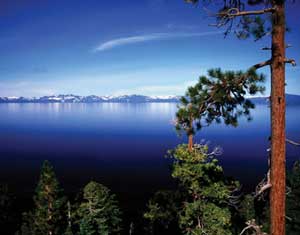Contact EPA Pacific Southwest Water Division
Pacific Southwest, Region 9
Serving: Arizona, California, Hawaii, Nevada, Pacific Islands, Tribal Nations
Watershed Priorities - Lake Tahoe, CA & NV

Photo courtesy of Tahoe Regional Planning Agency (TRPA)
Projects
On this page:
Funding
Funding the restoration of Lake Tahoe has been expensive and will continue to be costly into the future. Much of the funding for capital improvement and watershed projects, and scientific research has been from the Southern Nevada Public Lands Management Act (SNPLMA) which provides for the disposal of public lands in Clark County and in 2003, created a special account of the revenue generated by land sales to restore Lake Tahoe. New allocations of SNPLMA funds expired with signature of the final round of funding ($34 M) in August 2011, bringing the total expenditure over eight rounds to $300M. For more information on the current round of projects being funded, visit the Tahoe Basin Management Unit at the U.S. Department of Agriculture, Forest Service web site.
EPA-Managed Projects
EPA manages 4 cooperative agreements to support priority TMDL implementation activities. These projects primarily assist local jurisdictions with implementing BMPs, quantifying pollutant load reductions, and developing stormwater and watershed plans. They also help the oversight agencies carry out the lake clarity crediting program and improve data systems to provide for publicly accessible TMDL progress reports and build RCD capacity to provide technical support to the locals. EPA manages the grants for these projects and provides technical assistance. BLM provides funding for these projects under the Southern Nevada Public Land Management Act (SNPLMA) to support the Lake Tahoe Environmental Improvement Program (EIP).
| Title | Description | Recipient | Highlights | Timing |
|---|---|---|---|---|
| Lake Tahoe TMDL Management System | Develop and pilot an adaptive management system for TMDL implementation. System will provide consistent and transparent protocols to enable annual assessment of progress towards clarity goals, research to fill critical data gaps, and informed management decisions. Program will track loads from urban sources and activities for stream erosion, forest runoff and atmospheric deposition sources. Public will be able to access progress reports via the web. |
$584,325 awarded to Nevada Division of Environmental Protection (NDEP) |
CA RWQCB, NV DEP & EPA working together on program development and pilot phase. Produced first annual Synthesis of Findings and piloting on-line TMDL reporting. Overall focus on quantifying urban load reductions and engaging local jurisdictions to use crediting program to document progress and attain 5-year 10% load reduction milestone. |
Mar 2011 – Dec 2014 |
| Community Based Watershed Strategy Development | Engage private property owners, commercial businesses and local jurisdictions in development of 5 community-based watershed strategies to support TMDL implementation and protection of other environmental values. Promote regional approaches to stormwater management, building upon private property BMPs, to reduce FSP and nutrient loads. Build Nevada Tahoe Conservation District (NTCD) and Tahoe Resource Conservation District (TRCD) capacity to provide technical support to local jurisdictions for BMP implementation and maintenance and pilot use of improved stormwater tools for catchment registration. |
$747,000 total project. |
Phase I - RCDs working on area planning/regional approaches in 5 watersheds, two of which represent local Area Plans under the RPU. Phase 2 – Using improved stormwater tools from grant #3 below, RCDs will assist jurisdictions with beta testing of tools to calculate actual load reductions achieved since 2004 and register catchments. |
Mar 2013 – Dec 2015 |
| Stormwater Tools Integration and Improvement | Integrate and refine existing stormwater tools (suite of models, rapid assessment methodologies and accounting tools) to prioritize stormwater implementation actions for maximum load reduction and cost effectiveness. Create a user-friendly, web-based portal for local jurisdictions to enter urban pollutant loading data per the Lake Clarity Crediting Program. System will generate TMDL accomplishment reports, with increased ease of use, transparent stakeholder collaboration, and streamlined reporting and review. |
$480,000 awarded to Nevada Division of Environmental Protection. |
Engage jurisdictions to identify needed refinements to current tools, implement refinements and improvements, release and test improved tools, and document additional/future needs. Encourage jurisdictions to register catchments, perform inspections, and determine clarity credits. |
Mar 2013 – Dec 2015 |
| Tahoe Integrated Information Management System (TIIMS)/LT INFO | Integrate Environmental Improvement Program (EIP) database and reporting tool into Lake Tahoe Information Exchange (LT INFO) platform (replacing TIIMS for purposes of EIP reporting) to enable on-line reporting of EIP accomplishments, including TMDL load reductions for urban EIP projects and non-urban project performance measures. |
$669,000 to Tahoe Regional Planning Agency (TRPA) Phase 1: $60,000 to produce TIIMS strategic and financial plan. Phase 2: $214,000 to develop web-based EIP Reporting Tool. $108,964 spent (Phases 1 and 2). Phase 3: $395,000 to be awarded to TRPA |
Phase 1 – Consultant (Environmental Incentives) inventoried needs and developed strategic plan. Parties have endorsed recommendations and agreed to proceed with Phase 2. Phase 2 - TRPA hired consultant (Sitka) to develop EIP Reporting Tool and reconfigure TIIMS to create Lake Tahoe Basin Information Exchange. Sitka & TRPA are populating database for trial use to report 2014 EIP accomplishments. Phase 3 – Will be determined following tool development. Candidate projects include EIP reporting through 2016 and development of State of the Basin (i.e. ambient environmental) Reporting Portal |
Feb 2012 – June 2017. |
